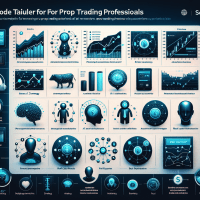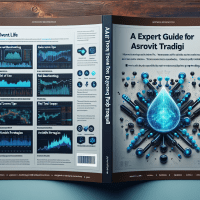Solvent.Life vs Vantir – AI Strategy vs AI Feedback Models: Advanced Prop Trading Insights
Prop trading professionals and enthusiasts constantly seek innovative strategies to gain an edge in today’s competitive markets. In this comprehensive guide, we compare Solvent.Life’s AI strategy model and Vantir’s AI feedback model, providing actionable insights for traders, quants, and risk managers. Discover detailed tool comparisons, backtesting methodologies, and compliance issues, all designed to empower you with a competitive advantage.
Understanding the Role of AI in Prop Trading
AI-driven models have revolutionized prop trading by automating the analysis of large datasets, optimizing parameter selection, and managing risk dynamically. As firms leverage AI strategies, understanding the differences between various models is crucial. Solvent.Life focuses on using AI to develop strategic models, while Vantir uses feedback-driven AI to refine and optimize trading performance in real time.
Why Prop Traders are Embracing AI?
Prop trading relies heavily on speed, precision, and data quality. AI helps eliminate human biases, allowing traders to simulate and deploy strategies with rigorous backtesting, reducing drawdown and improving overall performance metrics like the Sharpe ratio. For instance, a case study from a leading prop firm revealed that integrating AI models improved their risk management metrics by up to 20% in less than three months.

Figure 1: A snapshot of an advanced prop trading dashboard showcasing key backtesting metrics, essential for strategic decision-making.
Solvent.Life vs Vantir: Model Differentiation and Key Features
Both Solvent.Life and Vantir offer unique approaches to utilizing AI in trading environments. Below we highlight their core differences:
Solvent.Life AI Strategy
- Backtesting Features: Employs a hybrid approach combining event-driven and vectorized backtesting methods. The system can simulate various market conditions with an emphasis on minimizing overfitting and survivorship bias.
- Data Quality & Range: Provides extensive access to historical data spanning multiple asset classes, including equities, forex, and commodities. Real-time integrations enhance accuracy.
- Integration Capabilities: Offers robust API access and integrates seamlessly with platforms like TradingView, MetaTrader 5, and NinjaTrader. This allows for automated parameter optimization and comprehensive report generation.
- Pricing & Trials: Transparent tiered pricing with a free trial period; ideal for both prop firms and individual traders seeking scalable solutions.
- Use Cases: Best suited for developing proprietary trading strategies in a collaborative environment, enabling team-based risk management and strategy testing.
Vantir AI Feedback Models
- Backtesting Features: Utilizes automated feedback loops to adjust trading models based on live market performance and historical anomalies. Its simulation tools are designed to incorporate real market slippage and commission impacts.
- Data Quality & Range: Features a robust, continuously updated database, providing granular tick data alongside bar data for precise historical analysis.
- Integration Capabilities: Features strong broker integrations, connecting effortlessly with platforms such as MetaTrader 5 and Interactive Brokers for live deployment and continuous monitoring.
- Pricing & Trials: Offers competitive pricing with a freemium model, allowing traders to start with simulated feedback loops before full-scale deployment.
- Use Cases: Particularly useful for firms aiming to iteratively refine strategies with automated parameter re-optimization, ideal for rapid prototyping and performance tuning.
Advanced Backtesting Concepts and Best Practices
Backtesting remains a cornerstone for developing reliable trading strategies. Advanced prop trading setups now incorporate techniques that go beyond running historical data through models.
Identifying and Mitigating Common Backtesting Pitfalls
For prop traders and quants, overfitting and biases such as look-ahead bias or survivorship bias are common pitfalls that can compromise backtesting results. Here are some strategies:
- Robust Walk-Forward Optimization: Unlike traditional backtesting methods, walk-forward analysis continuously updates model parameters as new data emerges. Tools like QuantConnect and NinjaTrader facilitate this iterative process.
- Out-of-Sample Testing: Keeping a distinct data set for testing ensures that the strategy generalizes well. This method verifies the robustness of your trading model before live deployment.
- Integration of Forward Testing: Incorporate paper trading phases alongside backtested results. This step bridges the gap between simulation and real market conditions, ensuring readiness for live markets.
Case Study: Enhancing Strategy Performance in a Prop Trading Firm
Consider a scenario where a mid-sized prop firm aimed to refine its momentum trading strategy. The firm initially encountered issues with overfitting, resulting in unrealistic performance metrics. By integrating Solvent.Life’s strategic AI module, the firm adopted an automated parameter optimization approach and implemented an efficient walk-forward framework.
The results were significant: an improvement in the Sharpe ratio by 15%, a reduction in maximum drawdown by 10%, and faster iteration cycles. Additionally, the firm used Vantir’s feedback models to continuously adjust parameters based on emerging market conditions, ensuring that the strategy stayed robust over time.
Essential Trading Tools and Their Role in AI-Driven Backtesting
The effectiveness of AI in prop trading often depends on the tools used. Let’s compare a few popular platforms used by the industry:
| Tool | Backtesting Features | Data Quality | Integration | Pricing/Tiers | Use Case |
|---|---|---|---|---|---|
| TradingView | Vectorized backtesting, customizable scripts (Pine Script) | Extensive historical data, multi-asset coverage | APIs for third-party integrations | Free basic version, premium plans available | Ideal for retail traders and preliminary strategy tests |
| MetaTrader 5 | Efficient event-driven backtesting with automated optimization | Reliable historical data, broad forex support | Seamless broker integration | Free demo; broker-dependent pricing for live accounts | Suitable for both prop firms and individual traders |
| NinjaTrader | Advanced simulation and stress testing | High-quality tick data and real-time feeds | Flexible API, supports third-party analytics | Free for simulation; licensing for live trading | Best for high-frequency and algorithmic trading environments |
Expert Guidance on Integrating Backtesting Results with Live Trading
Deploying a strategy in a live environment after extensive backtesting requires care. Here are some essential best practices:
- Start with Paper Trading: Before committing real capital, test the strategy in a simulated market environment to validate real-time performance and execution speed.
- Monitor Key Metrics: Metrics such as maximum drawdown, profit factor, and Sharpe ratio should be continuously monitored. A sharp drop in any metric should trigger an immediate review of the underlying strategy.
- Compliance and Risk Management: Ensure all strategies align with regulatory frameworks like MiFID II, ESMA, and NFA guidelines. Incorporate automated risk management protocols to handle unexpected market moves.
Implementing Automated Algorithms: A Python Example
Below is a simple Python snippet that demonstrates using Backtrader for algorithmic backtesting. This example showcases the ease of integrating automated strategies into a systematic trading framework:
import backtrader as bt
class TestStrategy(bt.Strategy):
def __init__(self):
self.sma = bt.indicators.SimpleMovingAverage(self.data.close, period=15)
def next(self):
if self.data.close[0] > self.sma[0]:
self.buy()
elif self.data.close[0] < self.sma[0]:
self.sell()
if __name__ == '__main__':
cerebro = bt.Cerebro()
cerebro.addstrategy(TestStrategy)
data = bt.feeds.YahooFinanceData(dataname='AAPL', fromdate=bt.date2num(bt.datetime(2020, 1, 1)), todate=bt.date2num(bt.datetime(2021, 1, 1)))
cerebro.adddata(data)
cerebro.run()
cerebro.plot()
This simple moving average crossover strategy is a starting point that can be expanded into a full-fledged AI-driven model, integrating live data and advanced optimization techniques.

Figure 2: An in-depth backtesting report illustrating key metrics such as drawdown and Sharpe ratio, vital for optimizing prop trading strategies.
Bridging the Knowledge Gap: Key Takeaways for Prop Trading Professionals
For prop trading professionals, staying ahead means embracing both automation and rigorous testing. Whether you are a junior trader or a senior quant, the integration of advanced backtesting, live testing, and compliance measures is non-negotiable.
- Actionable Insights: Use tools like TradingView, MetaTrader 5, and NinjaTrader to backtest and validate your trading models efficiently.
- Expert Strategies: Incorporate walk-forward optimization and out-of-sample testing to mitigate biases and improve strategy robustness.
- Continuous Improvement: Leverage AI feedback models such as those from Vantir to continuously refine your strategies based on live market data.
Internal Links and Further Reading
For additional insights, visit our in-depth articles on Prop Trading Risk Management Techniques and Advanced Algorithmic Trading Strategies for prop firms.
Conclusion: Next Steps for Prop Trading Excellence
As of October 2023, staying current with AI-driven tools and advanced backtesting techniques is essential for maintaining a competitive edge in prop trading. We encourage readers to implement the strategies discussed and explore our additional resources, such as the Risk Management Checklist and our regularly updated Prop Trading Glossary.
For more advanced insights and live webinars discussing these trends, subscribe to our newsletter and join our community of prop trading experts.







